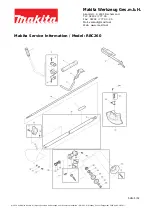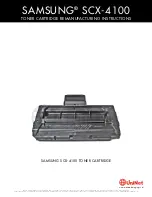
easily felt as shown in Figure 5. Make certain the burr is present along the entire length
of the edge. If there is no burr or only a partial burr, continue to make additional pulls all
in the left slot about five (5) at a time and check for a burr after each group of five (5)
pulls. In general 20-30 total pulls in the left slot will be adequate to raise a burr; it is
unlikely to take more than 50 left slot pulls to create the burr. When a burr is confirmed,
proceed to Step 2.
STEP 2
STROPPING/POLISHING THE FINAL
EDGE ON TRADITIONAL JAPANESE BLADE IN STAGE 3
(RIGHT HANDED BLADE)
a. Make five (5) regular pulls 3-4 seconds each only in the left slot of Stage 3 (Figure 9) and
then proceed to remove any burr as follows:
b. Make one (1) regular pull in right slot of Stage 3 along the back side of the edge.
c. Make several fast pulls (one [1] second each) in the left slot of Stage 3.
d. Make one (1) fast pull in the right slot of Stage 3.
Check the blade carefully for sharpness using a thin sheet of paper. The blade should be
razor sharp. If not razor sharp repeat 3c and 3d above and retest the blade for sharpness.
NOTE: If your traditional blade is excessively worn or if the edge is chipped and irregular
you can use the left slot of Stage 1 to recondition the edge. Use the left slot only (for right
handed blades). Make as many pulls as necessary to reestablish a smooth uniform edge
line. Use a black felt pen to mark facet and follow progress of sharpening along the edge
until edge line is restored. Then proceed in Stage 2 and 3 as described on page 8 and this
same page above.
RESHARPENING THE TRADITIONAL JAPANESE BLADE (RIGHT HANDED)
In general you will be able to resharpen quickly by following the sequence a thru d of Step
2 in the preceeding section. Repeat this if necessary to obtain a razor sharp edge. When
resharpening only in Stage 3 fails to develop a sharp edge or if the edge has been substan-
tially dulled you will need to re-hone the edge in Stage 2. Use only the left slot of Stage 2.
Generally you will find that about five (5) re-honing pulls will be sufficient in Stage 2. In any
event develop a burr before moving back to Stage 3. Finish the edge in Stage 3 following
Step 3a, b, c, d.
SHARPENING LEFT HANDED TRADITIONAL BLADES
The procedure you must use with left handed blades is similar to that procedure for right
handed blades as detailed above – Except, in all cases the slots you must use are reversed.
Where the sharpening procedure for right handed blades calls for use of just the left slot,
you must use only the right slot when sharpening a left-handed blade. Likewise use the
left slot where the right handed instructions call for using the right slot.
9


































